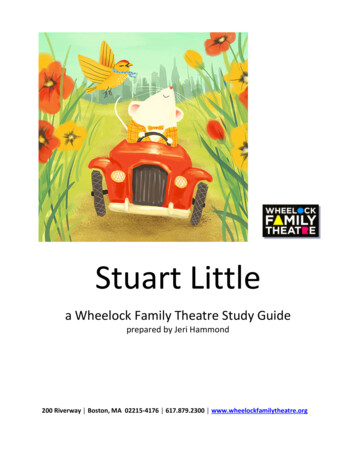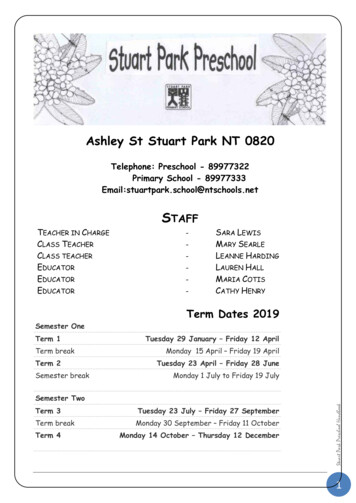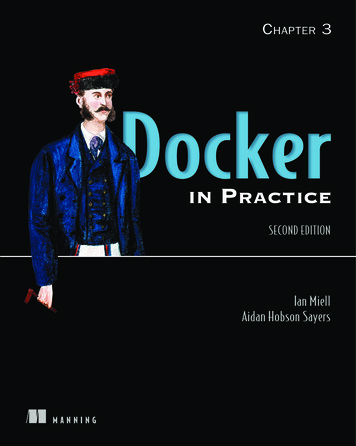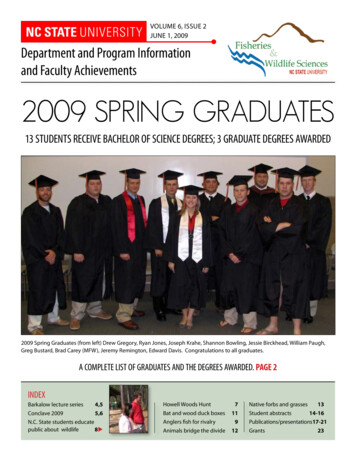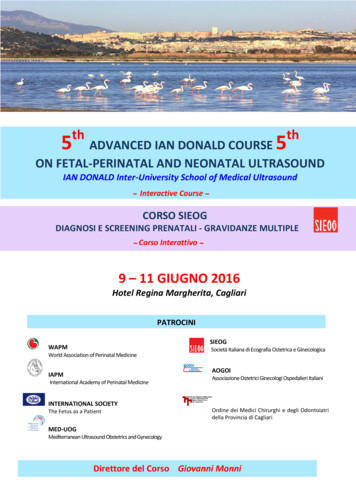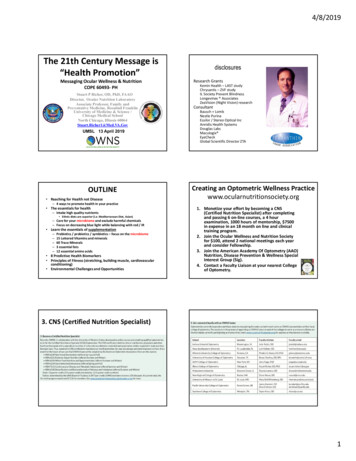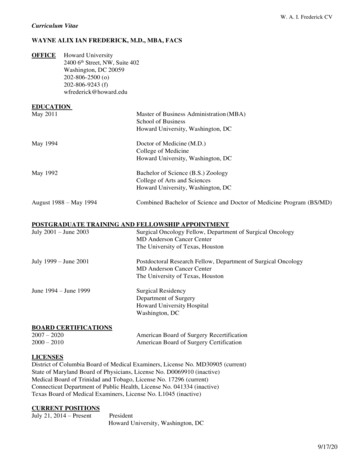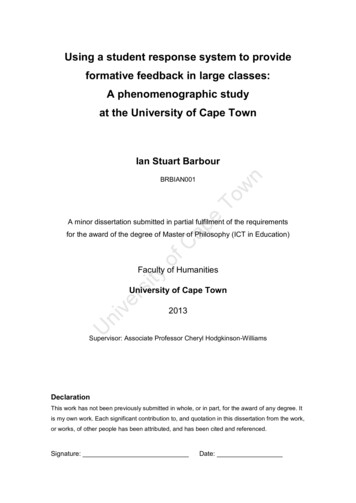
Transcription
Using a student response system to provideformative feedback in large classes:A phenomenographic studyat the University of Cape TownIan Stuart BarboureTownBRBIAN001apA minor dissertation submitted in partial fulfilment of the requirementsofCfor the award of the degree of Master of Philosophy (ICT in Education)ityFaculty of Humanities2013UniversUniversity of Cape TownSupervisor: Associate Professor Cheryl Hodgkinson-WilliamsDeclarationThis work has not been previously submitted in whole, or in part, for the award of any degree. Itis my own work. Each significant contribution to, and quotation in this dissertation from the work,or works, of other people has been attributed, and has been cited and referenced.Signature:Date:
nofCapeTowThe copyright of this thesis vests in the author. Noquotation from it or information derived from it is to bepublished without full acknowledgement of the source.The thesis is to be used for private study or noncommercial research purposes only.UniversityPublished by the University of Cape Town (UCT) in termsof the non-exclusive license granted to UCT by the author.
AbstractThe purpose of this study was to gain a better understanding of students’ conceptions of theuse of a student response system to provide formative feedback in large university classes.The main aim of formative feedback is to increase a student’s knowledge, skills, andunderstanding of specific subject matter, by indicating a gap between the actual knowledge ofthe student and the required standard. However, in large classes the opportunities forformative assessment are limited, often resulting in little or no immediate feedback given tothe students on their learning.One way of addressing this lack of assessment of students’ understanding in the classroom isnto incorporate a student response system into the lecture in order to facilitate learning andTowprovide immediate formative feedback. A student response system is a tool that enablesstudents to wirelessly send their responses to questions presented by a lecturer, using a smallehand-held remote-controlled device.apOver a seven week period, a TurningPoint student response system was used to support theCteaching of Information Systems to a class of first year students at the University of CapeofTown. Laurillard’s Conversational Framework was used as a theoretical framework to guideitythe pedagogical practice.rsAfter the teaching period, ten students were purposefully selected, and semi-structuredveinterviews were conducted with the objective of understanding the students’ conception of theuse of a student response system to provide formative feedback. The interviews were recordedniand transcribed, and the empirical data was analysed, using a phenomenographic approach.UPhenomenography is an empirically based method that uses semi-structured interviews toidentify different ways in which people experience a particular phenomenon. The result of thephenomenographic analysis was a set of categories of description that are hierarchicallyrelated, but qualitatively different from each other. These categories, along with the structuralthemes, formed the output of the data analysis.The results showed that the students experienced five different categories of feedback,including feedback about the correct answer to each question; about their understanding of thetopic; about what the lecturer should do; about the process of learning; and feedback aboutthemselves as a person.i
An analysis of the data showed that the students interviewed were assisted in theirunderstanding of the topic by the fact that the student response system provided the correctanswers immediately and visually. The anonymity of their responses aided the students toactively participate in class and not be distracted by the criticism of their peers. The studentsnoticed that the clickers provided immediate feedback to the lecturer and this enabled thelecturer to determine the level of understanding of the whole class. The feedback provided bythe system also enabled the students to ascertain if they understood the concepts or if theyneeded additional support.The results of this study were used to identify the learning activities that are supported by theuse of an SRS in the classroom and to develop an interpretation of Laurillard’s ConversationalapeTownFramework for a student response system.CKeywords:ofFormative feedback, student response system, Laurillard’s Conversational Framework,Universityphenomenographic approachii
Plagiarism Declaration1.I know that plagiarism is wrong. Plagiarism is to use another’s work and pretendthat it is one’s own.2.I have used the APA (6th edition) convention for citation and referencing. Eachcontribution to, and quotation in, this thesis from the work of other people hasbeen attributed, and has been cited and referenced.3.This minor dissertation is my own work.4.I have not allowed, and will not allow, anyone to copy my work with the intentionI acknowledge that copying someone else’s work, or part of it, is wrong andTow5.nof passing it off as his or her own work.apedeclare that this is my own work.CSignature:ofIan Stuart BarbourrsUnivebarbourians@gmail.comityStudent Number: BRBIAN001iiiDate:
AcknowledgementsIn the acknowledgements section of Stephen Covey’s book “The 8th Habit”, he talks abouthis experience of writing and likens it to climbing a mountain.After more than a year of teaching the material and writing, my team and Ifinished an initial rough draft – thrilled we had finally arrived. It was at thatmoment that we experienced what hikers often discover when climbingmountains: We hadn’t reached the summit at all, only the top of the first rise.From this new vantage point of sweat-earned insights we could see things wehad never seen before – ones only made visible at the top of that hill. So we setnour sights on the ‘real’ mountain and began the new climb. (Covey, 2004, p. x)TowThis research project has felt like that for me – often hoping that what lay ahead was thesummit, and each time coming to the realisation that there was another mountain ahead andapethat all I could do was to enjoy the “sweat-earned insights” and begin the new climb.But thankfully, as Stephen Covey points out, you cannot climb a mountain on your own andCthat the “most inspiring mountain climbing achievements in history are not so much stories ofofindividual achievement, but are stories of a unified, talented, prepared team that stays loyallyitycommitted to one another and to their shared vision to the end” (Covey, 2004, p. xi).rsWith this in mind I would like to take this opportunity to thank my “team”, those who walkedvewith me and helped me so much along the way:To my family for their ongoing encouragement and belief in me. To the students of INF1002H for sharing their experiences with me and for supportingme so enthusiastically. To Associate Professor June Pym and the staff of the Commerce Faculty AcademicDevelopment Program at UCT for encouraging me to never settle as a teacher and tokeep pushing forward. To my supervisor, Associate Professor Cheryl Hodgkinson-Williams, who hung inthere with me as the mountains came and the climbing was hard. To my fellow classmates at UCT who gave encouragement by sharing their ownstories with me. To all those who transcribed, read, edited and offered practical advice – your help wasgreatly appreciated.Uni iv
Abbreviations and AcronymsAcademic Development ProgramCLCComputer Literacy CourseEDUEducation Development ProgramICTInformation Communication TechnologyISInformation SystemsPCPersonal ComputerRFRadio FrequencyUCTUniversity of Cape TownUSBUniversal Serial BusWAVWaveform Audio FileTownADPeAlternative names for a Student Response System (SRS):apClickersAudience Paced FeedbackARSAudience Response SystemARTAudience Response TechnologyCCSClassroom Communication SystemCFSClassroom Feedback SystemCPSClassroom Performance SystemCRTClassroom Response TechnologyofityrsveniUERSCAPFElectronic Response SystemEVSElectronic Voting SystemGDSSGroup Decision Support SystemGRSGroup Response SystemIRSInteractive Response SystemLRSLearner Response SystemPRSPersonal Response SystemRTResponse TechnologyWCFSWireless Course Feedback Systemv
Table of ContentsList of Tables .viiiList of Figures . ixChapter 1 – Introduction . 11.1Introduction to the Problem . 11.2Background of the Study . 11.3Rationale and Objective . 41.4Research Question and Purpose. 51.5Nature of the Study . 51.6Organisation of the Document . 6TownChapter 2 – Literature Review . 8Introduction. 82.2Formative Assessment and Feedback . 82.3Research on Large Classes . 102.4Student Response Systems . 112.5SRS in Large Classes: Benefits and Challenges . 132.6Response System Pedagogy . 162.7Laurillard’s Conversational Framework . 192.8Response System Methodologies . 272.9Summary . 28versityofCape2.1Chapter 3 – Research Methodology . 29Introduction. 293.2Purpose of the Study . 293.3Research Question . 293.4Research Approach . 293.5Research Design . 313.6Data Collection . 353.7Data Analysis . 383.8Threats to Validity . 443.9Reliability . 45Uni3.13.10 Ethical Considerations . 473.11 Summary . 48Chapter 4 – Findings . 49vi
4.1Introduction. 494.2Categories of Feedback . 494.3Summary of the Outcome Space . 514.4Categories of Description . 52Category A: Feedback about the correct answer . 52Category B: Feedback about their understanding of the topic . 54Category C: Feedback about what the lecturer should do . 57Category D: Feedback about the process of learning . 59Category E: Self-directed feedback the students gave themselves . 62Comparison of the Categories of Description . 634.6Structural Relationships . 634.7Summary . 65Town4.5Chapter 5 – Discussion . 66Relating the Findings to the Conversational Framework . 665.2Learning Activities for a Student Response System. 685.3Conversational Framework for a SRS . 705.4Summary . 71Cape5.1ofChapter 6 – Summary and Recommendations . 72Problem Statement and Methodology . 726.2Summary of the Findings. 726.3Discussion of the Findings. 746.4Limitations . 746.5Recommendations. 756.6Concluding Remarks . 75University6.1References . 77Appendices . 83Appendix A – Clicker Lesson Plan Template . 83Appendix B – Interview Request Letter . 84Appendix C – Research Consent Form . 85Appendix D – Interview Protocol and Contextual Question . 86Appendix E – Interview Transcript for Dowelani . 87Appendix F – Software Packages Used. 92Appendix G – Research Poster . 93vii
List of TablesTable 3.1 – Pre-allocated pseudonyms . 36Table 3.2 – Summary of the interviews conducted . 37Table 5.1 – Learning activities that are supported by a student response system . 69UniversityofCapeTownTable 5.2 – Description of student response system learning activities . 69viii
List of FiguresFigure 1.1 – Model of assessment for first year students . 2Figure 2.1 – Turning Technologies radio frequency clicker and receiver . 12Figure 2.2 – The ConcepTest Peer Instruction implementation process . 18Figure 2.3 – TEFA Technology-Enhanced Formative Assessment . 19Figure 2.4 – Conversational Framework for the learning process . 20Figure 2.5 – Conversational Framework learning activities . 22TownFigure 2.6 – Representation of the Conversational Framework narrative line. 23Figure 2.7 – Representation of the narrative line for a student response system . 24eFigure 2.8 – A simplified version of Laurillard’s dialogue model . 26apFigure 3.1 – ATLAS.ti Hermeneutic Unit containing all relevant primary documents . 39CFigure 3.2 – Using the ATLAS.ti Code Manager to code quotations . 41ofFigure 3.3 – A model of feedback to enhance learning . 43ityFigure 4.1 – The five categories of feedback experienced by the students . 49rsFigure 4.2 – Outcome space showing the ways students experienced feedback . 51veFigure 4.3 – The structural relationships of the outcome space . 64UniFigure 5.1 – Relating the findings to Laurillard’s Conversational Framework . 67Figure 5.2 – Interpretation of the Conversational Framework for an SRS . 70ix
Chapter 1 – Introduction1.1Introduction to the ProblemOne of the many challenges facing universities today is how to deal with increasing class sizes,while still providing students with ongoing feedback and support. Many instructors struggle toimprove student participation, understanding of course concepts, and critical thinking withinthe context of large classes. Too often, lecturing seems to represent the only practical option tomanage large first year university classes (Mollborn & Hoekstra, 2010).Lecturers have adopted a number of different strategies and technologies to cope better withthese challenges, with the aim of encouraging effective learning in the classroom. One suchTowntechnology is the use of a student response system.In terms of classroom dynamics, a common goal in using a student response system is toeprovide an alternative to the traditional impersonal and anonymous large lecture. Trees andapJackson found that although a change in classroom culture can enable students to move fromCbeing passive observers to become more involved, “putting clickers in the hand of students,however, does not guarantee an engaged class” (Trees & Jackson, 2007, p. 25). It is thereforeofimportant to determine whether technology can assist in meeting the needs of a changingityeducational environment; hence the purpose of this study is to gain a better understanding ofniBackground of the StudyU1.2velarge classes.rsstudents’ experience of the use of a student response system to provide formative feedback inIn 2010 and 2011 I was a full-time staff member working in the Information SystemsDepartment in the Faculty of Commerce at the University of Cape Town (UCT)1. My dutiesincluded being the lecturer and convener for a first year course called “The Fundamentals ofBusiness Information Systems” (course code INF1002H) which I taught to approximately 75students who were on the programme of the Commerce Education Development Unit (EDU)2at UCT.The course was taught over a full calendar year, and the students were required to attend twolectures, one tutorial and one practical session each week, and to hand in a number of practicalassignments during the uct.ac.zaPage 1 of 93
The instructional goals of the course were: To ensure that the students develop content expertise in Information Systems (IS) To prepare the students for future learning by providing a foundation for further studiesin IS.1.2.1 Course structureThe INF1002H course structure is based on the “model for effective assessment” (Taylor,2008, p. 21) which proposes that a twelve week semester be divided into three overlappingniversityofCapeTownphases:UFigure 1.1 – Model of assessment for first year students(Taylor, 2008, p. 23)The phase assessment for transition provides opportunities to engage the students in theirstudies and to kick-start their activities in the course, with low contribution to final grades.Assessment for development is the heart of the course's assessment scheme and allows forsignificant feedback and low to middle contributions to the final grade.Assessment for achievement includes final assessments such as essays, portfolios andexaminations, with a high contribution to the final grade.The focus of the first three weeks of the semester is on assessment for transition and involves askills assessment, activities to assist students in understanding their learning skills, and aPage 2 of 93
course contract to “awaken the students to the specific needs of the course” (Taylor, 2008, p.24). This period allows the lecturers and academic support staff to identify students who havepoor skills or negative attitudes to learning, and it also allows time for the students to gain anunderstanding of what is required of them.Once engagement is established, a six week period of assessment for development follows,which focuses on increasing student engagement and confirming the students’ contentexpertise. The activities in this period are aimed at developing the skills necessary for latersuccess and have strong links with the later assessment for achievement. This period ischaracterised by numerous formative assessments providing ongoing feedback and support,with a low contribution towards the final mark. The emphasis is on communicatingninformation to each student, intended to modify their thinking or behaviour, for the purpose ofTowimproving learning. The information given to the students in this context is seen as formativefeedback, and it is in this phase that this research project is situated.eTowards the end of the semester there is a four week period of assessment for achievementapwhich includes examinations as well as the major essays, final portfolios, reports and projects.CThese summative assessments make up 60% of the final mark and provide few opportunitiesoffor developmental or formative feedback, with students only receiving summative feedback inityterms of their final mark.rs1.2.2 Student Response SystemveThroughout the semester a number of different technologies were used in the classroom tonisupport the pedagogical aims; one of them was a student response system (SRS).UA student response system, more commonly known as “clickers”, is a technology that enablesstudents to wirelessly send their responses to questions presented by a lecturer, by making useof a portable remote-controlled device. The technology involves a small hand-held device orwireless transmitter (the clicker) that uses radio frequency, with an alpha-numeric keypad thatallows students to respond to questions, which are presented in a multiple-choice format. Thequestions are displayed on a Microsoft PowerPoint slide, with additional software that works inwith MS PowerPoint and allows the question slide to show additional information such as ahistogram of the class responses (Mula & Kavanagh, 2009).Research has shown that using a student response system in the classroom encourages activelearning (Judson & Sawada, 2002); allows instructors to get precise real-time feedback (Lasry,Page 3 of 93
2008); is good at anonymous data collection (Poirier & Feldman, 2007); and encourages activestudent participation in large lecture classes (Mayer, Stull, Deleeuw, & Almeroth, 2009).The ability of the SRS to allow the lecturer to ask a question which requires a response fromthe students and then gives immediate feedback on the individual responses, appears to be aneffective means of providing formative feedback to a large class of students; it was usedextensively in this way to administer formative assessments during the INF1002H lectures.1.3Rationale and ObjectiveThe period of ‘assessment for development’ focuses on delivering numerous formativeassessments with a strong emphasis on formative feedback over a sustained period of time. Thenpedagogical premise underlying this phase is that “good feedback can significantly improveTowlearning processes and outcomes – if delivered correctly” (Shute, 2008, p. 154).This situation – the importance of formative feedback and the reliance of the SRS to deliver theefeedback – has given rise to the need for empirical research in order to determine if an SRS isapan effective mechanism for providing formative feedback in large classes.CThe need is for focused research to be undertaken in this area in order to provide a validoftheoretical argument for the adoption or rejection of the technology, rather than to just rely onrsINF1002H classroom.itythe anecdotal evidence that currently motivates the use of a student response system in theveThe objective of this research is to study the phenomenon of using a student response system toniprovide formative feedback, in order to determine the students’ conception of the effectivenessUof using an SRS to provide feedback in this manner. Understanding the students’ conception ofthe phenomenon will help the convenors of the course to better understand the benefits and/orlimitations of the use of an SRS as a pedagogical tool in the classroom.Although previous research has shown that good feedback can improve learning (Shute, 2008),it is quite possible that the use of an SRS is seen by the students as a hindrance to the learningprocess. On the other hand, students could also see an SRS as a positive influence and aneffective mechanism, or they could be neutral with respect to the impact of its use on theirlearning processes. The objective of this research is therefore to provide empirical evidencethat can be used to provide clarity on this discussion.Page 4 of 93
1.4Research Question and PurposeThis study takes a phenomenographical approach in order to gain an understanding of thestudents’ experience of the use of an SRS to provide formative feedback in large classes. Theresearch question is:What are the students’ conceptions of the use of a student response system to provideformative feedback in a large class?The question was selected in order to gain a better understanding of the variation of thestudents’ experience of the benefits and limitations of the use of an SRS to provide formativefeedback in large classes, as well as to guide future implementation of SRS technology at the1.5Townuniversity.Nature of the StudyThe study used the Conversational Framework (Laurillard, 2002) to guide the pedagogical useapeof the student response system in the classroom, while the data was analysed using aCphenomenographic approach.ofPhenomenography is “an empirically based approach that aims to identify qualitativelydifferent ways in which different people experience, conceptualise, perceive, and understandityvarious kinds of phenomena” (Marton, 1988, p. 53). The phenomenographic method usesrssemi-structured interviews with the participants in order for the researcher to understand theirveexperience of the phenomenon, in this case the use of a student response system to provideniformative feedback. The focus is on describing and understanding the range of experiences ofUthe whole group rather than on describing and understanding individual experiences. Theoutcome of phenomenographic approach is a set of categories of description and structuralthemes, represented hierarchically to form an outcome space.Ten students from the INF1002H class were purposefully selected, and semi-structuredinterviews were conducted, with the objective of understanding the students’ conception of theuse of a student response system to provide formative feedback in the classroom. Eachinterview was recorded and transcribed verbatim, and the interview transcripts became theempirical data for the qualitative data analysis phase.The transcripts were analysed by combining all relevant elements from all the interviews. Allquotations from all the transcribed interviews were identified and extracted in order to create asingle list of distinct quotations. Similar quotations were grouped and coded, and preliminaryPage 5 of 93
groups were created. This was an iterative process that continued until all quotations weregrouped and named. As the categories emerged from the data, these were identified anddescribed. Part of this process was the discovery of structural themes that described thesimilarities and differences between the categories.The outcome of this process was a set of five categories of description and three structuralthemes that constituted the phenomenographic outcome space.1.6Organisation of the DocumentThis mini-dissertation is organised into six chapters:Chapter 1 – IntroductionTownThis chapter provides an overview of the study as
Over a seven week period, a TurningPoint student response system was used to support the teaching of Information Systems to a class of first year students at the University of Cape . ARS Audience Response System . ART Audience Response Technology . CCS Classroom Communication System . CFS Classroom Feedback System .

